Expanding into UV flatbed printing can open fantastic new opportunities for an established large-format printing business. You’ll already know what many of the benefits are, whether it’s printing directly to a huge array of rigid and flexible substrates, the new products you’ll be able to produce, or the quantities you can produce them in. It’s quick, versatile, and profitable to produce high-value product personalisation, custom packaging, interior decoration or something nobody else has even thought of yet.
However, with so many options available, choosing the right UV flatbed printer for your specific needs can be daunting. It’s an investment, so it needs to be right for now, as well as the future.
1. Assess Your Production Volume Needs

A collection of printed phone cases
UV printers come in different sizes and print speeds, catering to different throughput requirements. The beauty of digital print is the ability to print on demand – you only need to produce what you sell. So, while waste and stockpiling are less of an issue, you need a device to keep up with demand without being excessive.
- Study consumer trends and identify your customers’ willingness to pay for your products. Analyse your competition and their pricing, product range, and market share. Identify gaps in the market that you can capitalise on.
- Develop optimistic, realistic, and pessimistic sales forecasts. Calculate the production costs, including materials, labour, overhead, and other expenses.
- Assess the potential for scaling up production volumes as demand grows, considering additional equipment, workspace, and personnel requirements.
Small businesses and those with lower volume needs will likely be happy with a desktop or benchtop model. They offer a compact footprint and budget-friendly pricing, while still capable of producing high-quality results at professional speeds. However, if you predict high-volume production or larger jobs, you’ll want to explore larger flatbed printers that offer larger print areas, faster print speeds, and enhanced features to keep up with demanding workloads.
2. Consider Your Maximum Print Size Requirements
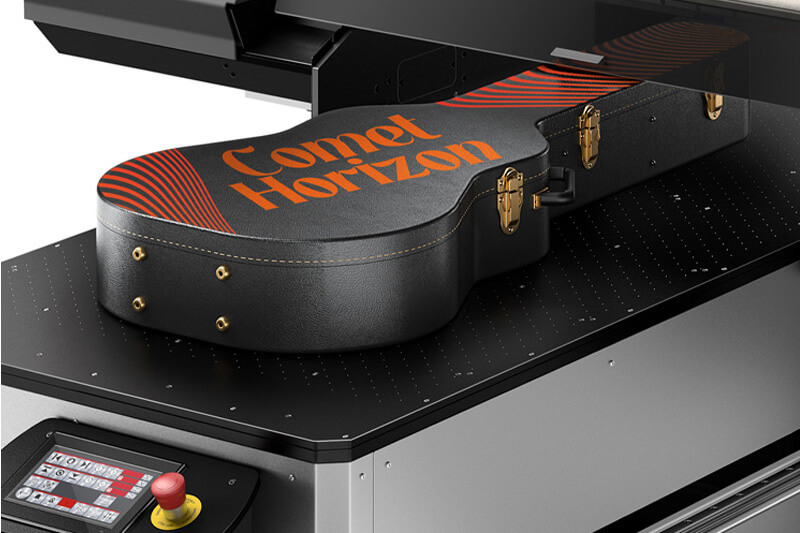
A guitar case on a flatbed printer with a printed graphic
Likewise, knowing what products you plan to sell (right away and in the future) will determine the size of machine you need. Yes, small items like promotional USB sticks or phone cases can be done on a smaller flatbed, and for many businesses that will be ideal, but be sure to consider other products you could produce in the future. Equally, if you anticipate printing larger signage, POS displays, or other oversized graphics, you'll need a flatbed printer with a print area that can accommodate those dimensions. If you’ve already checked this and you fear your items are too large, be sure to check with your Dealer or product expert because some machines can be modified with factory parts to increase print height.
3. Evaluate Substrate Versatility
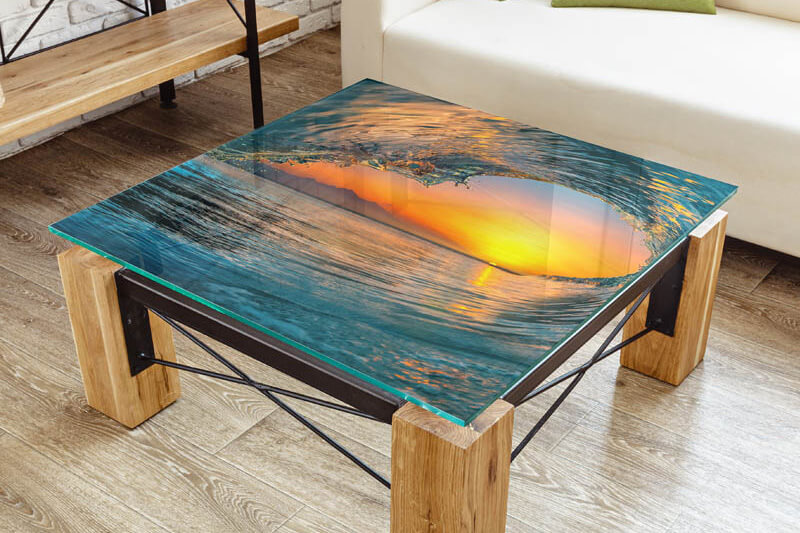
A glass tabletop with a printed image of a wave
One of the key advantages of UV flatbed printing is the ability to print directly onto a wide range of rigid and flexible substrates, from metal and wood to glass and leather. With a little help from primer, there are very few materials you can’t print to. So, beyond what products you want to produce and what materials you want to print them on, make sure you consider:
- Material Compatibility – Think about media durability, weight, or aesthetics and ensure the device can cope with what you are producing.
- Cost Optimisation – Depending on the application, some substrates may be more cost-effective than others. A versatile printer allows you to choose the most economical substrate suitable for each job, optimising your production costs.
- Sampling – If a client requires you to create prototypes or samples using different materials, a printer capable of handling various substrates allows you to test and showcase your designs on the intended production materials.
- Future Adaptability – As new materials and substrates emerge or become popular in the market, a versatile printer can adapt to these changes, keeping you competitive.
4. Prioritise Print Quality and Colour Accuracy
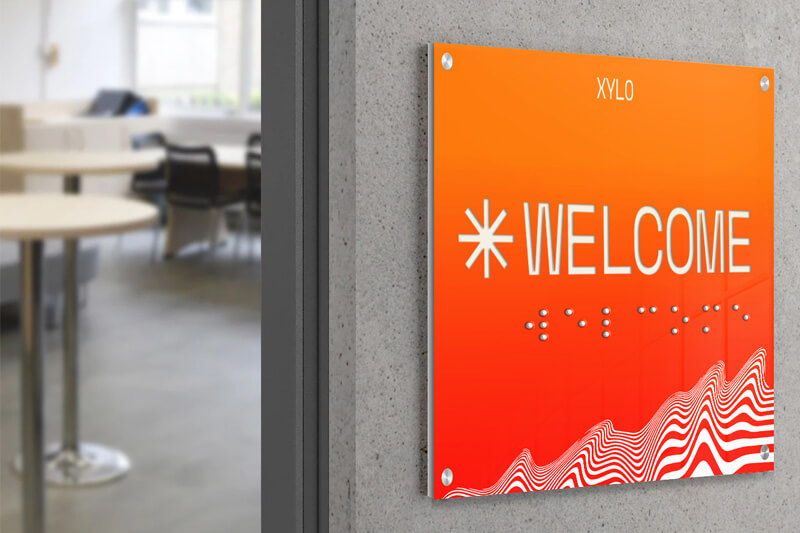
A printed orange sign with braille text
Pay close attention to print resolution, ink configurations, and colour management capabilities offered by different models. Powerful colour management tools and ICC profiling capabilities ensure accurate and consistent colour reproduction across various substrates and even devices. If you produce branded signage and banners for a client, being able to offer them promotional merchandise that you can guarantee will be a colour match will be a big bonus.
5. Consider Workflow Automation and Software Integration
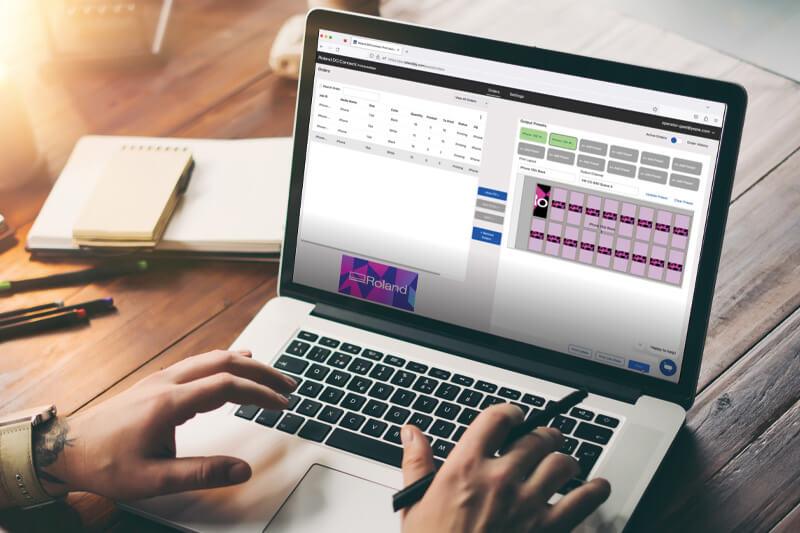
A person using PrintAutoMate on a laptop
Printer manufacturers are putting a lot of effort into streamlining print processes and flattening the learning curve wherever possible. Many devices have features that allow them to integrate seamlessly with your existing workflow and software. From intuitive interfaces that can simplify job setup to powerful but easy-to-use RIP software packages, such as Roland DG’s VersaWorks 6, these features can significantly reduce manual intervention, minimise errors, and improve overall efficiency.
If you can purchase your new UV flatbed printer within the same brand as your other device(s), not only will you be familiar with many of their features already, but they often work off the same systems or even allow for integration. Roland DG Connect PrintAutoMate, for example, allows users to automatically map incoming jobs to their related jigs and output devices for printing high volumes of items, meaning you can automate the printing of 6 phone cases to a small flatbed and 10 electronic panels to a larger flatbed.
6. Evaluate Ongoing Operating Costs
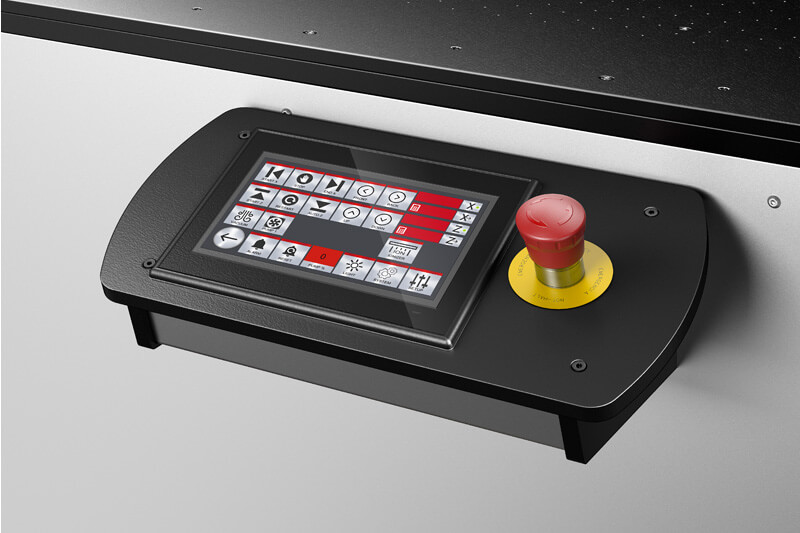
A control panel with a red button
While the upfront cost of a UV flatbed printer is a significant investment, it's essential to consider the ongoing operating costs as well. Factors such as ink consumption, printhead longevity, and maintenance requirements can vary significantly between different models and manufacturers.
Research and compare these costs carefully, as they can have a substantial impact on your overall profitability over the lifetime of the printer. There are solutions available, such as Roland DG Connect, that give you insights into various business processes like job profitability and costs, as well as device monitoring and health checks to keep downtime to a minimum.
7. Prioritise Reliability and Service Support
Downtime can be costly, so reliability is key. As much as we hope things won’t go wrong, it’s best to plan for when they might. On top of device reliability, you want to know that the service and support you receive will be high-quality and prompt.
Manufacturers might offer comprehensive warranties, readily available spare parts, and responsive technical support to minimise potential disruptions and ensure your printer remains productive. Roland DG Care is an industry-leading warranty plan that provides full coverage with no hidden costs, replacement genuine Roland DG parts, rapid call-out response and more.
8. Future-proof Your Investment
It’s already been mentioned, but it bears repeating: factor in your potential for future growth. Anticipate potential increases in production volume or changes in application requirements, both in what you can produce and what the customer will demand. Demands change and so must your ability to meet them.
Choosing an upgradeable system can help future-proof your investment, allowing you to adapt to evolving market demands without the need for a complete overhaul of your equipment.
Conclusion
It’s undoubtedly exciting to be in the market for a new UV flatbed printer, but it’s also daunting. However, the number of options available works in your favour as long as you plan carefully, evaluate your specific needs, consider the factors above, and speak to the experts. You’re sure to find the perfect solution to propel your printing business forward.
If you’d like any more information on anything you’ve read in this article, our product experts would be happy to help. Please contact us.

